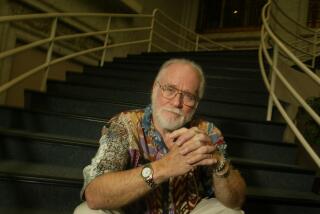Joseph J. Musil dies at 73; theater designer with a flair for showmanship
Joseph J. Musil, a Santa Ana-based theater designer with a flair for showmanship and a reverence for a bygone era of movie-going whose work included the restoration of the El Capitan Theatre in Hollywood and the transformation of the Crest Theater in Westwood, has died. He was 73.
Musil, who had a long history of heart disease and diabetes, died of heart failure June 28 in a convalescent hospital in Orange, said his brother, Robert.
“Joe had an unlimited imagination,” said Ed Collins, general manager of the El Capitan, the Disney-operated movie palace on Hollywood Boulevard. Musil worked as designer for the restoration that culminated in the theater’s 1991 reopening.
“Since he was 4, he just loved theaters, especially movie theaters, and that was reflected in his work,” Collins said. “If you walk into the El Capitan, it’s fun. The colors, the designs and everything are uplifting.
“He didn’t re-create a museum here; it was an experience. In this case, it preserved the experience of the golden age of movie-going.”
In his first project involving Disney and Pacific Theatres in the late 1980s, Musil transformed the Crest from a plain, shoebox neighborhood movie-house into what Collins called an Art Deco gem featuring decorative plastic moldings, a fiber-optic star ceiling and black-lighted murals of 1930s-vintage Hollywood landmarks.
“It was pure imagination on that one,” Collins said. “The El Capitan was more restoration, of putting the theater back to what it looked like when it was new in 1926.
“What Joe always said was, ‘We’re putting on a show here.’ And his signature was the curtain show. Back in the old days, theaters had curtains right in front of the screens, and the number of curtains denoted how deluxe the theater was. At the El Cap, Joe designed a three-curtain show.”
Among Musil’s other theater projects were the restoration of the Fine Arts Theatre in Beverly Hills, which reopened in 1993; and the Maverick Theater in Fullerton, a playhouse that, The Times reported in 2005, was “intended to evoke a 1920s Hollywood speak-easy.”
Musil’s studio in the historic Santora Arts Building in downtown Santa Ana was a 1,500-square-foot space he called the Studio of the Theatres.
Stepping into the studio, The Times reported in 1997, “was like stepping into an ornate movie palace from the 1920s, complete with vintage pipe organ music in the background.”
The studio included exhibits of highly detailed miniature models of old theaters that Musil had built over the years, complete with rising curtains on pulleys and lights hung from rigging — as well as displays of toy theaters, a collection of Art Deco theater lobby items and an actual stage framed by a proscenium arch he designed.
“For a designer,” Musil said, “it’s extremely important to be psychologically in the mood, and this is my personal space to inspire myself for the work I do.”
Musil was born in Bell on Jan. 25, 1937, and grew up in nearby South Gate and Long Beach. A trip to the movies with his grandmother in 1941 proved to be the defining moment of his life.
The theater was the Strand in Long Beach, where the price of admission included a live stage show complete with orchestra, dancers and singers.
“It was a mystical happening in my life,” Musil told The Times in 1997, recalling the musical fanfare and changing colors of the lights on the curtain, which opened to reveal a second curtain.
“These are sort of like innocent things, but it was theatricality that they were adding to the film,” he said. “They were presenting the film to you.”
Nowadays, he said, “there’s no sense of anticipation. There’s no sense of mystery. There’s no sense of you feeling you’re really going someplace or like you’re a special person when you go there.”
A graduate of Wilson High School in Long Beach, Musil furthered his love of movie theaters by working his way up from usher to house manager of the Fox West Coast Theatre in Long Beach when he was 19.
He graduated from Chouinard Art Institute in Los Angeles and studied interior design and set design for grand opera at the Academy of Fine Arts of Brera in Milan, Italy. He also served in the Army.
Musil’s brother, who is his sole survivor, said he’s looking for a buyer for the contents of the Studio of the Theatres, which includes a library of books on theater and Art Deco and Musil’s professional archives.
Robert Musil said the exhibit space, which was visited by the public during the building’s monthly open house, was just a sideline to his brother’s business and “doesn’t generate any money the way it is.”
Collins said he and many others hope Musil’s collection will be kept together.
But for Collins and his colleagues at the El Capitan, “we have the real thing here; we work in Joe’s creation. We brag it up all the time.... People come here because it’s a unique experience.”
More to Read
Start your day right
Sign up for Essential California for the L.A. Times biggest news, features and recommendations in your inbox six days a week.
You may occasionally receive promotional content from the Los Angeles Times.






